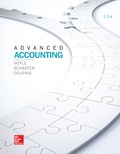
Concept explainers
1.
Explain the reason why Company A acquire Company M.
2.
Explain the way in which the consideration transferred allocated between cash paid and the contingent consideration.
3.
Provide a schedule showing Company A’s allocations of the consideration transferred to the identifiable assets acquired and liabilities assumed with the remainder going to
4.
Compute the maximum potential contingent payout (i.e., earn out) to the former owners of Company M. Although not explicitly stated in Company A’s fiscal 2015 10-K report (for the year ended March 31, 2015), Explain some possible factors that entered into the determination of the acquisition-date fair value of the contingent consideration.
Want to see the full answer?
Check out a sample textbook solution
Chapter 2 Solutions
Soft Bound Version for Advanced Accounting 13th Edition
- You are a team of accounting consultants hired by the company VinGrenDom Ltd., a regional utility and manufacturing firm expanding into the Eastern Caribbean. The Board of Directors is requesting an accounting report that addresses three critical areas in their financial statements. Part A: Working Capital 1. Define working capital and explain its importance in financial health and liquidity management. 2. Assess how the matching concept and accrual basis affect the reporting of current assets and liabilities. 3. Using a hypothetical balance sheet (you may create one), identify at least 5 current assets and 5 current liabilities and analyze how changes in these elements affect liquidity ratios. 4. Recommend at least two strategies VinGrenDom Ltd. can implement to optimize working capital.arrow_forwardProvide best solution accountingarrow_forwardGeneral Accounting solve this problemarrow_forward
- Explain the theoretical concepts underlying equity (e.g., residual interest, stewardship, and proprietary theories)arrow_forwardGeneral Accounting Questionarrow_forwardSea Harbor, Inc. has a marginal tax rate of 35 percent and an average tax rate of 22 percent. If the firm earns $79,500 in taxable income, how much will it owe in taxes? a. $10,335. b. $16,695. c. $17,490. d. $27,030. e. $27,825.arrow_forward
- Principles of Accounting Volume 1AccountingISBN:9781947172685Author:OpenStaxPublisher:OpenStax College




